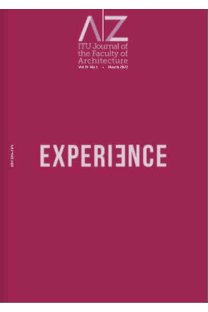A parametric landscape urbanism method: The search for an optimal solution
___
Bergen,S. D., McGaughey, R.J, Fridley,J. L. (1998). Data-driven simulation, dimensional accuracy and realism in a landscape visualization tool. Landscape and Urban Planning, 40, 283-293.Castro, E., Ramírez, J. A, Rico, E. (2013). The Grounds of a Renewed Practice. Architectural Design, 78-86.
Çolakoğlu, B. (2006). Explorations in Teaching Design Students to Think and Produce Computationally Communicating Space(s).Proceedings of 24th eCAADe Conference, Volos, Greece; 826-831.
Dimcic, M. (2011).Structural Optimization of Grid Shells Based on Genetic Algorithms.PhD dissertation. Institute of Building Structures and Structural Design, University of Stuttgart.
Erdem, M. (2012). Revaluating ecology in contemporary landscape design, A|Z ITU Journal of the Faculty of Architecture, 9, 1, 37-55.
Ervin,S.M. (2001). Digital landscape modeling and visualization: A research agenda. Landscape and Urban Planning, 54, 49-62.
Eşbah, H., Erdoğan M. A., Akin Tanrıöver A. (2011).Cellular automata-Markov chain and landscape metrics for landscape planning, A|Z ITU Journal of the Faculty of Architecture, 8, 2, 63-79.
Frazer, J. (1995). An Evolutionary Architecture. AA Publications, London. Frazer,J. (2016). Parametric Computation: History and Future. Architectural Design. 18-23.
Galapagos. Retrieved from http:// www.grasshopper3d.com/profiles/ blogs/evolutionary-principles. Access date: 14. 08. 2016
Holden, R., Liversedge, J. (2014). Landscape Architecture: An Introduction. Laurence King Publishing, London.
Kawamura, H., H. Ohmori. (2001). Computational Morphogenesis of Discrete Structures via Genetic Algorithms.Memoirs of the School of Engineering, Nagoya University, 53, 1/2, 28-55.
Kvan, T., Mark, E., Oxman, R.,Martens, B. (2004). Ditching theDinosaur: Redefining the Role of Digital Media in Education.InternationalJournal of Design Computing.
Mostafavi, M., Doherty, G. (2010). Ecological Urbanism. University Graduate School of Design, Lars Müller Publishers.
Moughtin, C., Shirley, P. (2006). Urban Design: Green Dimesions, Architectural Press, Elsevier, Boston.
Pallasmaa, J. (2007). New Architectural Horizons. Architectural Design, 16-23.
Palmboom, F. (2010). Drawing the ground: Landscape urbanism today. Birkhaeuser, Basel.
Passino, K.M. (2005). Biomimicry for Optimization, Control and Automation. Springer Verlag, London.
Piegl, L., Tiller, W. (1997).The Nurbs Book. Springer-Verlag, Berlin.
Schumacher, P. (2009). Parametricism: A New Global Style for Architecture and Urban Design. Architectural Design, 14-23.
Schwarz, M. (2011). Recycling Spaces Curating Urban Evolution: The Landscape Design of Martha Schwartz Partners. Thames & Hudson, London.
Spens, M. (2007). From Mound to Sponge: How Peter Cook Explores Landscape Buildings. Architectural Design, 12-15.
Surya. S. (2016).Landscape Ecological Urbanism for Restoration of Pallikaranai Marsh Land, Chennai, Tamil Nadu.International Conference on Emerging Trends in Engineering, Science and Technology (ICETEST- 2015). Procedia Technology. 24 (2016), 1819-1826.
Terzidis, K. (2006). Algorithmic Architecture. Elsevier, Oxford-UK.
Turrin, M., von Bülow, P., Kilian, A., Stouffs, R. (2012). Performative skins for passive climatic comfort: A parametric design process. Automation in Construction, 22, 36-50.
Von Bülow, P. (2007). An intelligent genetic design tool (IGDT) applied to the exploration of architectural trussed structural systems. PhD dissertation. ILEK, University of Stuttgart.
Von Bülow, P. (2008). Using Evolutionary Computation to explore geometry and topology without ground structures. Proceedings of the 6th International Conference on, Computation of Shell and Spatial Structures IASS-IACM 2008: Spanning Nano to Mega. Cornell University, Ithaca, NY.
Von Bülow, P., Falk, A., Turrin, M. (2010). Optimization of structural form using a genetic algorithm to search associative parametric geometry.Structures & Architecture, Proceedings of the First International Conference on Structures and Architecture, Portugal.
Waldheim, C. (2006). The landscape urbanism reader. Princeton Architectural Press, New York.
Wolfram. Retrieved from http:// mathworld.wolfram.com/NURBSCurve.html. Access date: 14. 08. 2016.
- ISSN: 2564-7474
- Yayın Aralığı: 3
- Başlangıç: 2005
- Yayıncı: İTÜ Rektörlüğü
Causes of disputes in the Turkish construction industry: Case of public sector projects
Do architects' and users' reality coincide? A post occupancy evaluation in a university lecture hall
BAŞAK ÖZER, YASİN ÇAĞATAY SEÇKİN
Vacancy and access to food: Spatially addressing food insecurity in urban Appalachia
Cermetrius L BOHANNON, Nikolus HENRY
A parametric landscape urbanism method: The search for an optimal solution
A study on the daily life and coffeehouse culture in Gaziantep: Tahmis Coffeehouse
A conceptual process model for the sustainability of a healthy building
ASUTAN SARP YALÇIN, Ayşe BALANLI
The archetypes of landscape and sustainable design in the ksar of Kenadsa
Evaluation of the physical environment in Anatolian rural architecture
Do architects' and users' reality coincide? A post occupancy evaluation in a university lecture hall
